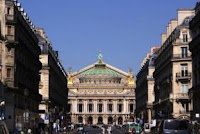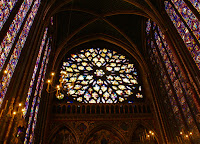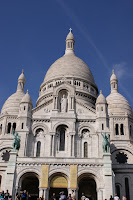Je t’aime Paris which means “I love Paris” is a very common catch phrase we often see in many of the souvenir items from Paris. Many would say, it is just a marketing gimmick to attract tourist to buy them. However, as I explore around the city, this simple phase has proven to be very real. Staying and exploring Paris for a couple of days created a personal meaning and made me fall in love in this old yet very beautiful city. A city that is uniquely Paris.
Paris has always been in my bucket list. And I think I am not alone on this dream. Many would agree that at least once in our lifetime, we wanted to climb up the Tower of Eiffel, look for the hunchbacked of Notre Dame (even if it is just a myth) or examine at close distance the world renowned smile of Da Vinci’s Mona Lisa. As my first pleasure trip in Europe, I made sure that I got the luxury of time to do all those things. A carefully planned itinerary about arts, history, churches, architecture and food were the focus of my five days tour in the city of love. Simple as it may seem, picking the places of interest that will fit within my schedule was a big challenge at first. Paris is a huge city and there are tons of things to do and places to visit but the must see on my list included the Eiffel of course, The Louvre for its Mona Lisa, Notre Dame for its famous Stained Glass Rose window, Arc Du Triomphe and The Grand Palace of Chateau de Versailles.
 |
| View of Paris from my hotel |
Boarding the United Airlines flight from George Bush Intercontinental Airport in Houston bound for Paris with a 5-hour stopover at John F. Kennedy Airport in New York City, the long awaited vacation to the city of love finally was happening. I arrived 7:00 morning time the next day at Charles de Gaulle Airport in Paris. To save time and avoid getting lost in this huge city, I decided to take the taxi heading to my hotel, The Residence Du Palais located opposite the Luxembourg Garden, a pension house right at the heart of Paris and at the 6th arrondissements (or administrative districts). With just a 5-minute walk to Notre Dame des Champs Metro station, it was indeed a perfect choice as my temporary abode in Paris; a decent room with all my necessities and a small balcony giving me a visible view of the Eiffel and the city of Paris.
One of the easiest ways to explore Paris is using the “City Pass”. The pass allows access to many of the major museums and tourist places in Paris. But the really good deal for having this card is the express access to all the tourist places and skip the long queue of tourists. This is the reality facing many tourists in Paris and this can be annoying or worst a nightmare for those traveling on very a tight schedule. And so, I followed many of the past travelers advise to buy the card. Paying a couple of euros for the convenience and worry free tour was well worth it. Before kicking off my tour, I dropped by the tourist office located at 25, Rue des Pyramides to collect my pass.
 |
| Notre Dame des Champs Station |
 |
| Academe Nationale de Musique |
Not far away from the Tourist Information Center, actually just a couple of blocks away is the Academe Nationale de Musique or the Opera Nationale de Paris. The building cannot be ignored for its very strategic location and grand facade. The two gold plated sculptures on top of the building will surely catch tourists’ attention. As I get closer to this massive theater, I got to appreciate it more including its huge sculptures. I love taking photos of different architectures and this was a welcome treat. If I am not an engineer, I probably have taken architecture instead. This is just one of the many beautiful architectures that spread across Paris and it gets better and better as I further explore the city. After taking a couple of pictures, I headed next to my destination, the “M ‘O”. From Opera Metro Station, I took the metro to the Musée d’ Orsay Station for the first time.
TAKING THE METRO IN PARIS
Using the metro in Paris was nothing different in taking the subway in Seoul. It was confusing by just looking at the metro map but once you get the hang of it, it actually is very simple. Taking the “Metro” is the most convenient means of transportation. I purchased a 5day train pass which allows me to go around without having to purchase a ticket every time am taking the subway. Outside of Paris, the ticket is invalid and a separate ticket is necessary. The train pass can be purchased inside the station booth or using the machine. It is also an important reminder to keep the ticket as you will need it at exit gates. For five days, I used my train pass without trouble. One more thing, download the phone application "Paris Metro" for convenience of tracking your route while commuting to avoid getting lost in a rather complicated train system of Paris.
MUSÉE D’ ORSAY

The M ‘O or the popularly known as the Musee d’ Orsay is a must visit museum for diggers of impressionist and post impressionist masterpieces. The works of the famous painters like Monet, Manet, Degas, Renoir, Matisse and of course the very famous Van Gogh are well curated and housed in what used to be a railway station converted into a grandiose museum. A perfect example of preserving a piece of history while putting it into good use. Upon arrival at the museum entrance, I asked the guard and he directed me to the dedicated entrance for city card holders. True enough, it was indeed an express lane. I got to approach the receptionist very quickly to claim my ticket. For housing some of the world’s priceless art pieces, photography is prohibited in some areas of the museum. The art pieces are just hanging on the wall without any special glass encasing but the whole building is provided with well controlled ventilation. Some tourists may not realize that “NO PHOTOGRAPHY” is not only for security but more importantly, it is a protection to these centuries old treasures. Camera flash generates huge amount of heat which can start chemical reaction which eventually deteriorate the color of the paints. So the next time you see the “NO PHOTOGRAPHY” sign, let’s all be civilized about it. We’re giving the future generation a huge favor and giving them the chance to appreciate these artworks as well. With its almost 6,000 art pieces and 3000 of which are on permanent display, it took me the whole afternoon to complete the tour. Moving from one chamber to the next, I tried to check with curiosity every paintings and sculptures. Art lovers will surely enjoy every piece of painting on display. One of the most visible piece of artwork inside museum is the giant clock located on the main hall. On the topmost floor of the building is a terrace overlooking the city of Paris and the river Seine. A beautiful place to end my first day tour in Paris.
 |
| Inside Musee D' Orsay |
 |
| At the front of Musee D' Orsay |
 |
| View of the Musee D' Orsay and the River Seine by the bridge |
 |
| View of the Sacre Cœur from Musee D' Orsay viewing deck |
MY CHURCHES DAY IN PARIS
Growing up with a very religious grandparents influenced me to really practice my religion so whenever I go, I made sure that I stop by a nearby Catholic Church. And being on a tour does not excuse me from doing the same and to offer some prayers. But apart of being a Catholic, my fascination of the churches started since I was young; the grand architecture and history behind the centuries old house of worship had given me the desire to explore more. So, for my second day in Paris, I specifically set it as a “church day”. Topping my list of course is the famous Notre Dame Cathedral which is located right at the heart of the city of Paris.
THE SACRÉ CŒUR
Before visiting the Notre Dame Cathedral, I headed first to the minor basilica know as Basilique du Sacré Cœur (or Basilica of the Sacred Heart of Paris) located at the summit of butte Montmartre. The church is very iconic for its location as well as its very white color. There are several ways of climbing up this church but I took the Paris Metro and get off at Anvers station. As I exited the station, I was surprised to see a black dominated community. I must admit, I was a bit scared at first but as I made my way to the foot of the church hill, it slowly died down. It was quite a walking from Anvers station and indeed an early exercise for me. Be warned though that at the foot of the hill were sellers who will try to grab you by the hand and attach some bracelets of sort. The best way to avoid these rude fellows is to just continue walking and avoid making an eye contact. As I climb up the church ground, I am getting the glimpse of the picturesque view from the top but the more dramatic view is from the dome of the church so I decided to hike up the dome. The few steps was manageable but as I go up further to its 300 spiral stairways, I started to catch by breath. Taking the stairs is the only way up, a climb that is not for the physically fit nor for the claustrophobics. What awaits at the top however is a breathtaking and panoramic view of Paris. The cold morning breeze suddenly washes away all the fatigue from going up. As I scan the 360 view, a very recognizable shape and unmistakably the Eiffel appeared like keychain figure from afar. I spent a couple of minutes to enjoy this view before I started my descent to explore the main church.
The Sacre Cœur is actually a minor basilica and in contrast to the Gothic style of the Notre Dame, the Sacré Cœur was inspired by Saint Sofia of Constantinople and San Marco in Venice. Having seen the San Marco, I must agree with the familiar resemblance. From afar the church projects a white color mainly because of the travertine stone know as the Chateau Landon which is extremely hard and fine and exudes calcite when in contact with rainwater (by Wiki). Inside of the church is a huge mosaic depicting the image of the Risen Christ which is considered one of the largest in the world. At the outside, just sitting and enjoying the view was an excellent therapy of being away from the chaos of the city. Should I have enough days to spare, I can spend the whole day just relaxing and reading a book from this spot.
 |
| Inside Sainte-Chapelle |
 |
| The Stained Glass Windows of Sainte-Chapelle |
 |
| Hall of Guards inside The Conciergerie |
As much as I want to stay longer in this serene sanctuary, I needed to move and head to my next destination. I took the same path in going back to Anvers station and hopped to the train heading to Saint Michael Notre Dame. Around the Notre Dame were several places of interests such as the Sainte-Chapelle and the Conciergerie. Sainte-Chapelle is a royal medieval Gothic Chapel located near the Palais de la Cité. Though this chapel has been damaged during the French Revolution, its restoration has retained one of the extensive in-situ collection of the 13th century stained glass which cannot be found anywhere else in the world. At the time of my visit, half of the chapel was undergoing restoration work so only a part of this grand chapel is open to the public. Fifteen huge glass windows fill the nave and apse of this chapel and a huge rose window dominates the western wall. Important episodes from the old and new testaments were depicted in each of the huge stained glasses. Though not all were available, I can imagine the great detail and magnificent colored reflections it creates during the day. Having spent for an hour or so and after taking some photos, I got to appreciate and examine the level of detail and artistry of the interiors and the stained glasses of Sainte Chapelle. Indeed a chapel that is fit for the royalty. Several videos were on display explaining the meticulous and the delicate process of the restoration work. Just within the vicinity is the Conciergerie so I headed next to this old prison place.
 |
| Prison cell of Marie Antoinette |
Within the île de Cité, a building part of the former royal palace but later transformed into a prison during the French Revolution is The Conciergerie. Walking inside this facility created an eerie feeling to me probably because of its dark role during the French revolution. All the prisoners for execution by guillotine were held up in this old palace including France’s very popular queen Marie Antoinette. The first section upon entry is the Hall of the Guards which is the largest surviving medieval portion of Conciergerie. Further exploring inside is a very simple and small prison cell of the former queen; well preserved and one of the few areas open to the public. At present time, most of the parts of this old palace/prison is still in use for some court functions. And finally, I was off to the famous Notre Dame Cathedral.
(CONTINUATION, SEE PART 2)






No comments:
Post a Comment